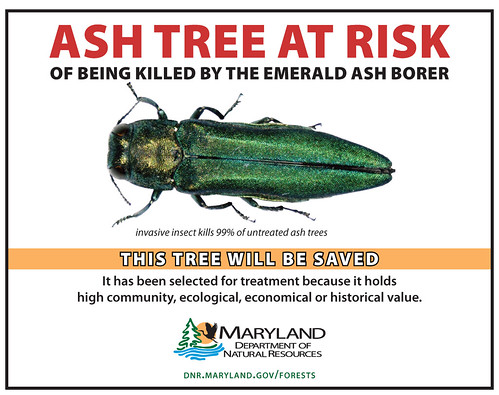Maryland Working to Protect State Parks from Destructive Emerald Ash Borer

These signs will be posted on trees receiving treatment
The Maryland Department of Natural Resources is working to protect ash trees from the emerald ash borer – an invasive beetle that feeds on and kills native ash trees – treating about 300 trial trees at 16 state parks starting in mid-May. This destructive beetle has spread rapidly since it was first discovered in Maryland in 2003.
“Ash trees are a critical component to a healthy forest, providing shade, improving air and water quality, and serving as habitat for countless species,” Maryland Park Service Superintendent Nita Settina said. “As you can imagine, their aesthetic, environmental and economic value is immeasurable. This project seeks to protect hundreds of healthy ash trees from emerald ash borer while engaging the next generation of stewards in natural resource management.”
The Maryland Park Service and the Maryland Conservation Corps will perform targeted treatments to safeguard healthy trees at parks including Big Run, Cunningham Falls, Gunpowder Falls, Janes Island, Sandy Point and Susquehanna. The project is a cooperative effort between the Departments of Natural Resources and Agriculture, with funding provided by the U.S. Forest Service.
Since this beetle was discovered on the Eastern Shore in 2015, the entire state has been under the federal emerald ash borer quarantine, which limits the movement of Maryland ash products to other regions/states under quarantine. However, as a best practice, the Maryland Forest Service strongly encourages citizens to use locally-sourced wood to avoid further spread and threats to healthy trees in quarantine zones.
“The actions we take now are critical in preventing the loss of priority trees and speeding the recovery of ash populations in the future,” Maryland Forest Service Director Don VanHassent said. “The Department of Natural Resources is fortunate to have experts from the Department of Agriculture with the know-how and resources to help us appropriately battle this persistent pest.”
The only reliable way to protect trees from the borer is chemical treatment (emamectin benzoate), although biocontrol efforts utilizing natural predators are being developed that may be useful in the long term.
